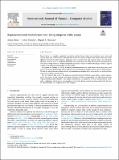Representational transformations : using maps to write essays
Abstract
Essay-writing is a complex, cognitively demanding activity. Essay-writers must synthesise source texts and original ideas into a textual essay. Previous work found that writers produce better essays when they create effective intermediate representations. Diagrams, such as concept maps and argument maps, are particularly effective. However, there is insufficient knowledge about how people use these intermediate representations in their essay-writing workflow. Understanding these processes is critical to inform the design of tools to support workflows incorporating intermediate representations. We present the findings of a study, in which 20 students planned and wrote essays. Participants used a tool that we developed, Write Reason, which combines a free-form mapping interface with an essay-writing interface. This let us observe the types of intermediate representations participants built, and crucially, the process of how they used and moved between them. The key insight is that much of the important cognitive processing did not happen within a single representation, but instead in the processes that moved between multiple representations. We label these processes `representational transformations'. Our analysis characterises key properties of these transformations: cardinality, explicitness, and change in representation type. We also discuss research questions surfaced by the focus on transformations, and implications for tool designers.
Citation
Binks , A , Toniolo , A & Nacenta , M 2022 , ' Representational transformations : using maps to write essays ' , International Journal of Human-Computer Studies , vol. 165 , 102851 . https://doi.org/10.1016/j.ijhcs.2022.102851
Publication
International Journal of Human-Computer Studies
Status
Peer reviewed
ISSN
1071-5819Type
Journal article
Description
This research was supported by NSERC (The Natural Sciences and Engineering Research Council of Canada) RGPIN-2020-04401 and EPSRC (Engineering and Physical Sciences Research Council) EP/T518062/1.Collections
Items in the St Andrews Research Repository are protected by copyright, with all rights reserved, unless otherwise indicated.

